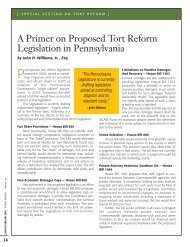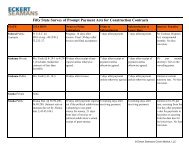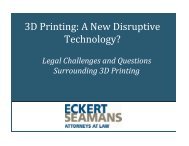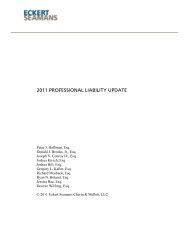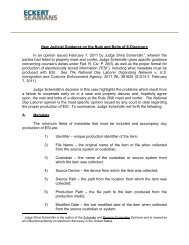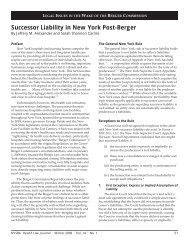sliced his wrist and arm with a razorblade. Id. at *2. Nearly one (1) year after his initial request,the decedent hung himself with a bed sheet in his cell. Id. at *3. Among other claims, theplaintiff, administrator of the decedent’s estate, set forth a claim of corporate liability againstMHM. Id. at *4. Specifically, the plaintiff alleged that “MHM’s policies prevented [thedecedent] from receiving proper in or outpatient psychiatric care, and that these policies weremotivated by MHM’s desire to maximize profits.” Id. at *3. The plaintiff maintains that, due toMHM’s policies, the decedent did not receive appropriate care, which caused a decline in hismental health and ultimately his death. Id.The defendant MHM filed a Motion to Dismiss pursuant to Federal Rule of CivilProcedure 12(b)(6). Id. at *4. In its motion, the defendant argued, inter alia, that the “plaintiffhas failed to state a claim of corporate liability as this is a limited cause of action in Pennsylvaniawhich does not extend beyond hospitals.” Id. at *7. The district court noted that thePennsylvania Supreme Court had not yet ruled on this issue; therefore, it was tasked atattempting to predict how that court would rule. Id. The court agreed with prior decisions of theEastern District of Pennsylvania, as well as other lower Pennsylvania state courts, which havepermitted corporate liability claims against private companies, such as MHM. Id. Specifically,the court explained that the Pennsylvania Courts have held institutions liable where the patients“[h]ad been constrained in their choice of medical care options by the entity sued.” Id.Moreover, the court noted “[n]o difference between the services provided by a hospital and theservices provided by health care institutions in prisons.” Id. Consequently, the court concludedthat “[a] corporation which provides medical services must be held to the same duty of care ashospitals.” Id. at *8. The court further found that the plaintiff had sufficiently pled this claim.Accordingly, the defendant’s Motion to Dismiss was denied on this issue. Id.See also Vochinksy v. Geo Group, Inc., 2009 WL 4017254 (E.D. Pa. Nov. 20, 2009)(holding plaintiff failed to state corporate liability claim where plaintiff failed to allege corporatedefendant’s knowledge of defect in procedure that resulted in harm to plaintiff).In Stroud v. Abington Memorial Hospital, 546 F. Supp. 2d. 238 (E.D. Pa. 2008), theUnited State District Court for the Eastern District of Pennsylvania held that, under the moreliberal federal pleading standards, Plaintiff sufficiently pled a claim of corporate negligencedespite failing to allege that Defendant hospital was aware of its inadequate policies andprocedures.In Stroud, Plaintiff sued Defendant Abington Memorial Hospital (“Abington”) followingthe death of his father due to complications after knee surgery. In the Complaint, Plaintiffalleged that Abington was negligent for failing to have in place and enforce proper policies andprocedures for interdepartmental communication. Id. at 242. Defendant Abington subsequentlyfiled a Motion to Dismiss pursuant to Federal Rule 12(b)(6), arguing, inter alia, that Plaintiff’sSecond Amended Complaint failed to state a claim for corporate negligence by “fail[ing] toadequately plead that it knew or reasonably should have known of the alleged failings in itspatient care procedures.” Id. at 245.Taking into the account the relaxed federal pleading standards, the court held thatalthough plaintiff had not expressly pled that Abington actually or constructively knew of thealleged defects in its patient care procedures:68
The Second Amended Complaint does however contain a detailedrecitation of the facts upon which the corporate negligence claim ispredicated. In addition, he specifically pled, among other things,that Hospital failed to have proper rules, policies, and proceduresin place concerning communication of critical test results andavailability of existing patient medical records from prioradmissions. He also specifically pled that Hospital failed toenforce its existing rules, policies, and procedures concerning suchmatters. These pled facts are certainly sufficient to give notice toHospital that Plaintiff reasonably asserted that its interdepartmentalcommunication procedures were deficient, and that this deficiencywas the predicate upon which the corporate negligence claim wasbased.Id. at 246 (citations omitted).Accordingly, the court concluded that Plaintiff’s corporate negligence claim stated alegally cognizable cause of action under the Federal Rules, and Abington’s motion to dismisswas denied (the corporate negligence claim was ultimately dismissed on other grounds,however). Id.(iii) Expert testimony RequiredUnless the matter under investigation is so simple and the lack of skill or want of care isso obvious as to be within the ordinary experience and comprehension of even non-professionalpersons, a plaintiff must produce expert testimony to establish that the hospital deviated from anaccepted standard of care and that the deviation was a substantial factor in causing the plaintiff’sharm. Welsh v. Bulger, 548 Pa. 504, 698 A.2d 581 (1997).In Rauch v. Mike-Mayer, 2001 Pa. Super. 270, 783 A.2d 815 (2001), appeal denied, 568Pa. 634, 793 A.2d 909 (2002), the Superior Court held that where a hospital’s negligence is notobvious, Plaintiff’s expert witness must, in order to make out a prima facie case of medicalmalpractice, establish the following: (1) that the hospital deviated from the standard of care; and(2) the deviation was a substantial factor in bringing about the harm. Plaintiff’s experts’ reportsin this case had fulfilled these requirements and, therefore, the trial court had erred in grantingDefendant’s Motion for Summary Judgment. The Superior Court reversed.(iv) Certificate of Merit RequiredA claim for corporate negligence against a hospital (or other qualifying corporate entity)requires the filing of a proper Certificate of Merit stating that an appropriate licensedprofessional has opined in writing that there is a “reasonable probability” that the care, skill, orknowledge associated with the treatment, practice, or work of the defendant fell outsideacceptable professional standards and that such conduct was a cause in bringing about the harm.See Pa. R. Civ. P. 1042.3; see also, Rostock v. Anzalone, 904 A.2d 943 (Pa. Super. Ct. 2006);Weaver v. Univ. of Pittsburgh Med. Ctr., No. 08-411, 2008 U.S. Dist. LEXIS 57988 (W.D. Pa.July 30, 2008). Critically, a Certificate of Merit submitted in support of a corporate negligenceclaim must allege that the corporate entity itself deviated from the appropriate standard of care,not that the corporate entity’s liability is based solely upon the actions or inactions of other69
- Page 3 and 4:
EMTALA CASES ......................
- Page 5:
Filing an Affidavit of Non-Involvem
- Page 8 and 9:
II.PROFESSIONAL LIABILITY - AN OVER
- Page 10 and 11:
The Superior Court reversed the tri
- Page 12 and 13:
to a third party pursuant to the st
- Page 14 and 15:
After approximately five months, De
- Page 16 and 17:
learned the day after the surgery t
- Page 18 and 19:
conduct to the delay in colon cance
- Page 20 and 21:
court admitted the expert’s testi
- Page 22 and 23:
(b)(c)other reasonable causes, incl
- Page 24 and 25: corroborated his testimony. The cou
- Page 26 and 27: husband’s estate. Plaintiff alleg
- Page 28 and 29: Other notable federal cases arising
- Page 30 and 31: The Superior Court found that in re
- Page 32 and 33: § 1303.512(b). The court, however,
- Page 34 and 35: In Neidig v. United States, No. 07-
- Page 36 and 37: Additionally, the Supreme Court not
- Page 38 and 39: were not indicated for her conditio
- Page 40 and 41: surgeon is the same as it would be
- Page 42 and 43: It should be noted that the Superio
- Page 44 and 45: Finally, the court held that the tr
- Page 46 and 47: The Supreme Court of Pennsylvania r
- Page 48 and 49: nurses deviating from applicable st
- Page 50 and 51: certainty, the court reviews expert
- Page 52 and 53: Under Pennsylvania law, the Court n
- Page 54 and 55: testimony, Defendant presented his
- Page 56 and 57: Following Cooper v. Roberts, 286 A.
- Page 58 and 59: Plaintiff developed chronic diarrhe
- Page 60 and 61: where payment is made by Medicaid w
- Page 62 and 63: accomplished. In Valles v. Albert E
- Page 64 and 65: In 1980, the Pennsylvania Superior
- Page 66 and 67: Plaintiff had a routine monitoring
- Page 68 and 69: Plaintiff’s Contract ClaimsThe Co
- Page 70 and 71: is a failure to report changes in a
- Page 72 and 73: unit to assure post-surgical patien
- Page 76 and 77: licensed professionals for whom the
- Page 78 and 79: (c)Limitations of Corporate Neglige
- Page 80 and 81: Even more recently, our Superior Co
- Page 82 and 83: (a)HMO IssuesIn McClellan v. Health
- Page 84 and 85: affidavit submitted by Defendants o
- Page 86 and 87: treatments while at VA’s faciliti
- Page 88 and 89: [s]ubstantively, we believe that a
- Page 90 and 91: The party claiming the benefit of t
- Page 92 and 93: deprive (him) of civil rights guara
- Page 94 and 95: found that the District Court was w
- Page 96 and 97: With respect to fraudulent concealm
- Page 98 and 99: would be applied in situations wher
- Page 100 and 101: they had not raised them in the cou
- Page 102 and 103: (a)Informed ConsentUnder MCARE, a p
- Page 104 and 105: civil enforcement provisions and ma
- Page 106 and 107: MCARE also changes the manner in wh
- Page 108 and 109: whose death, in 2005, was allegedly
- Page 110 and 111: vicariously liable if the plaintiff
- Page 112 and 113: health center or its equivalent or
- Page 114 and 115: In Pennsylvania Medical Society, th
- Page 116 and 117: to any professional who is alleged
- Page 118 and 119: Since the 2005 amendments, there ha
- Page 120 and 121: ule, but who intentionally ignores
- Page 122 and 123: the original Complaint was delivere
- Page 124 and 125:
foreclose all challenges against th
- Page 126 and 127:
number of boxes), which was support
- Page 128 and 129:
questions of professional judgment
- Page 130 and 131:
deviated from any professional stan
- Page 132 and 133:
The Third Circuit affirmed the Dist
- Page 134 and 135:
claims and cross-claims remain agai
- Page 136 and 137:
By an Amendatory Order dated March
- Page 138 and 139:
The court acknowledged that there i
- Page 140 and 141:
apply and that the trial court misa
- Page 142 and 143:
Barbados had enough litigation-spec
- Page 144 and 145:
E. Preemption of Vaccine Design Def
- Page 146 and 147:
2. Pa. R. Civ. Pro. 1036.1 - Reinst
- Page 148 and 149:
Barrick, at *34-35.Furthermore, the
- Page 150 and 151:
(b) the utility of the defendant’
- Page 152 and 153:
2006). In this case, Plaintiffs bro
- Page 154 and 155:
B. Elements of a Cause of Action fo
- Page 156 and 157:
decision in Muhammad precluded Mr.
- Page 158 and 159:
considered speculative “only if t
- Page 160 and 161:
underlying cause of action involved
- Page 162 and 163:
In Capital Care Corp., the Superior
- Page 164 and 165:
The court found, however, to state
- Page 166 and 167:
of reasonable diligence. The standa
- Page 168 and 169:
not be set aside. On July 7, 2005,
- Page 170 and 171:
complete bar to recovery. Since a l
- Page 172 and 173:
On appeal, Plaintiffs claimed that
- Page 174 and 175:
In Liggon-Redding, 659 F.3d at 265,
- Page 176 and 177:
elieved of those minimum standards
- Page 178 and 179:
elevant to the proceedings, the com
- Page 180 and 181:
establish professional misconduct b
- Page 182 and 183:
Upholding the Superior Court’s Or
- Page 184 and 185:
Id.Rejecting revocation and suspens
- Page 186 and 187:
order as a sanction under Rule 4019
- Page 188:
{1009912]182



